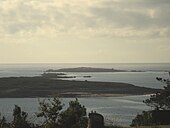Île Guennoc
| Île Guennoc | ||
|---|---|---|
| Waters | Atlantic Ocean | |
| Geographical location | 48 ° 36 '2 " N , 4 ° 38' 9" W | |
|
|
||
| length | 550 m | |
| width | 300 m | |
| surface | 13 ha | |
| Residents | uninhabited | |
Île Guennoc , also called Gaignoc or Guénioc , is a small uninhabited island in the French commune of Landéda ( Finistère department ) in Brittany . The island on the Côte des Abers is around 550 m long and up to 300 m wide.
Early history
The megalithic complexes on the Île Guennoc were partly built around the Cairn of Barnenez and the complex on the Île Carn (around 4200 BC) and are among the oldest in the world.
At the time the Cairns were built , sea levels were 4–5 m lower. The offshore stretch of coast is now flooded by the sea and the small island on the reef of Aber Vracht is difficult to reach. A boat takes you across from the Prat-ar-Coum oyster bay. Not far from the Île Guennoc, when the tide is low on the islet Roc'h-Avel , you can see a corridor made of dry masonry that has been gnawed by the sea . The monument, which was flooded today during floods, like the Allée couverte by Kernic and the Allée couverte in the Estuaire de la Quillimadec , was well above sea level at the time of construction.
The Guennoc dolmens are divided into groups of different sizes on four preserved cairns on the ridge of the island. There are mainly open tholoi and, more rarely, stone slab graves. A trapezoidal cairn with four parallel tholoi and long tangential corridors was extended on its broad side. The new section houses two oppositely oriented tholoi, so one is oriented differently than all the others. The round chambers often only reach half their height. At the entrance to some of them there are schematic silhouettes on slate. They represent the goddess. Some stone slabs show faded engravings (U-signs). In Tholos 3 there is an anthropomorphic menhir near the entrance .
The dolmens were furnished with rich grave goods consisting of pottery and flint . Freed from the ruins of their superstructure, the complex, trapezoidal Cairns reveal monumental facades. In front of these facades were small squares where rituals were performed. In one place on the forecourt, a considerable amount of pot shards was found.
Some dolmens were still used in Gallic times (clay dishes). In addition to three Neolithic Cairns, there is also a medieval hermitage here .
Recent history
Later the island became a sheep farm. During World War II it served as a repatriation base for British airmen. Today the island is only inhabited by seagulls and small, kelp-eating rabbits .
See also
literature
- Jacques Briard : Mégalithes de Bretagne . Ouest-France, Rennes 1987, ISBN 2-7373-0119-X .
- Giot, Pierre-Roland: Prehistory of Brittany. Menhirs and dolmens . Editions d'Art Jos Le Doaré, Châteaulin 1996, ISBN 2-855-43-103-4 .
- Jürgen E. Walkowitz: The megalithic syndrome. European cult sites of the Stone Age (= contributions to the prehistory and early history of Central Europe. Vol. 36). Beier & Beran, Langenweißbach 2003, ISBN 3-930036-70-3 .

